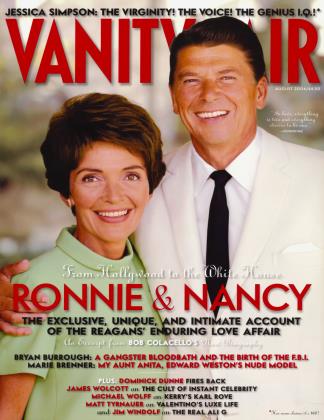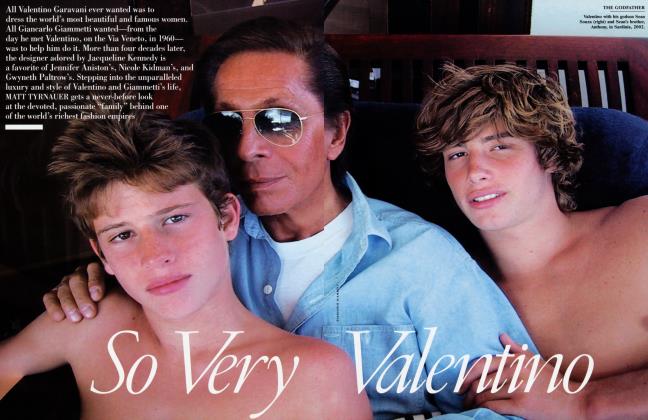Sign In to Your Account
Subscribers have complete access to the archive.
Sign In Not a Subscriber?Join NowCONTRIBUTORS
In March 1981, special correspondent BOB COLACELLO was introduced to Ronald and Nancy Reagan by Jerry Zipkin at New York's famous Le Cirque restaurant. In 1997, VF. assigned Colacello to profile the couple. The story grew into a book, the first volume of which is excerpted in this issue (see page 158), and Nancy Reagan grew to become a friend. "I write about the how and the why," Colacello says. "How did these two people from Dixon, Illinois, and Chicago, Illinois, end up in the White House?" Just three weeks after finishing Ronnie and Nancy: Their Path to the White House, Colacello attended Reagan's funeral in Washington. "Nancy's quite a woman, and she will carry on—if only for his legacy," he says. "She will transfer her devotion for him to devotion for his cause."
When PATRICK DEMARCHELIER turned 17, his stepfather gave him a Kodak, sparking his interest and prompting him to take a job outside Paris printing and retouching passport photos. After 10 years of assisting photographers, Demarchelier moved to New rk in 1975 to launch a career that now spans four decades. "I love the challenge of photography," he says.
"I get to create something new every day. For what I don't accomplish today, there's always tomorrow." Long known for his iconic covers for Harper's Bazaar, Demarchelier counts among his famous subjects Coco Chanel, Prince, and Hillary Clinton. His shoot this month, of Jessica Simpson (see page 166), is his first as a VF. contributing photographer.
As a child, writer-at-large MARIE BRENNER thought of her aunt Anita, whom she writes about in this issue, mostly as the author of a children's book called The Timid Ghost; family tensions prevented Brenner from ever really knowing the woman who had been the subject of Edward Weston's famous Pear-Shaped Nude. "My aunt was a woman of secrets and drama," Brenner says. Only later did she learn about the complexities of Anita's life. "I discovered she was a presence in the world of modem art and a major figure of her era, and yet she remained for many as elusive a personality as she was for me." Brenner is at work on a memoir of her family, Special correspondent BRYAN BURROUGH fondly recalls listening to his grandfather, a onetime deputy sheriff, describe manning roadblocks set up in rural Arkansas in 1933 to capture Bonnie and Clyde. Burrough's new book, Public Enemies: America's Greatest Crime Wave and the Birth of the F.B.I., 1933-34, excerpted in this issue, uses recently released case files to chronicle the fateful two-year period when J. Edgar Hoover's fledgling bureau chased down John Dillinger, Baby Face Nelson, Machine Gun Kelly, and Ma Barker, as well as Bonnie and Clyde. "Few people today realize that all these criminals were at large at the same moment in history and that the modern F.B.I. was born of these manhunts," Burrough says. "It's fascinated me since I was nine years old."
CONTINUED ON PAGE 93
CONTINUED FROM PAGE 88
For this issue, contributing photographer JONATHAN BECKER accompanied worldrenowned designer Valentino across Europe, capturing images of the man who revolutionized the Italian fashion world. After 40 years at the top of the heap, Valentino remains surrounded by a familial group of friends who include his business partner, Giancarlo Giammetti, and his longtime P.R. rep, Carlos Souza. "Carlos and I are old friends, and Valentino I have photographed intermittently over the years," says Becker, shown, far left, with the designer. "Valentino is a special kind of patriarch." After working once more with the designer and his associates, Becker found himself warmly embraced by the whole clan.
According to editor-at-large MATT TYRNAUER, the relationship between designer Valentino and his business partner, Giancarlo Giammetti, is a moving example of how an empire can be founded on friendship. "Valentino and Giancarlo complement each other perfectly," says Tyrnauer, whose profile of the pair begins on page 190. "European friends of theirs pointed out that people in the U.S. who back same-sex marriage should look at the way these two built their lives. They didn't need a wedding, because they had a stronger unconventional bond. And besides, they're Catholics." Tyrnauer has also written about Siegfried and Roy, Martha Stewart, and Frank Gehry for V.F.
 View Full Issue
View Full Issue






Subscribers have complete access to the archive.
Sign In Not a Subscriber?Join Now